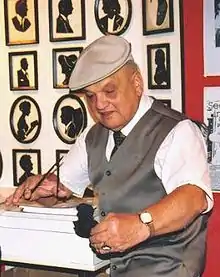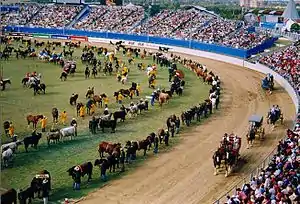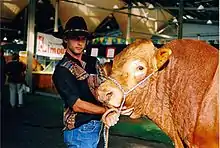Sydney Royal Easter Show
First held in 1823, the Sydney Royal Easter Show, commonly shortened to The Easter Show is an annual show held in Sydney, Australia over two weeks around the Easter period. It comprises an agricultural show, an amusement park and a fair and combines the elements of each, showcasing the judging of livestock and produce. The Royal Agricultural Society of New South Wales is responsible for the event. Queen Victoria awarded the society and its show the right to use the word "Royal" in its name.[1]
| Sydney Royal Easter Show | |
|---|---|
 | |
| Begins | 1 April 2021 |
| Ends | 12 April 2021 |
| Frequency | Annual |
| Location(s) | Sydney Showground |
| Inaugurated | 1823 |
| Most recent | 12 April 2019-23 April 2019 |
| Attendance | 922,000 (2017) |
| Organised by | Royal Agricultural Society of New South Wales |
| Website | www.eastershow.com.au |
The Show is a celebration of Australian culture, from rural traditions to modern day lifestyles, providing unique experiences for everyone. Every Easter, the country and city join together at Sydney Showground, Sydney Olympic Park, for twelve days of agricultural competitions, animal experiences, live entertainment, carnival fun, shopping and much more.[2]
The Show has many competitions, including arts and crafts, photography and cookery, as well as tests of strength and skill such as wood chopping. The show also has shopping, restaurants, commercial stands, such as a showbag pavilion and exhibits, a horticultural display, and stage and arena shows. It also even hosts a breed based conformation dog show and cat show, which are nationally accredited. In 2017, 922,000 people attended the show.
Revenue generated by the Sydney Royal Easter Show allows the Royal Agricultural Society of NSW (RAS) to invest in agricultural programs, competitions, education, youth and rural NSW. In all, the RAS invests almost $7 million annually in these activities which are designed to promote agricultural excellence and to build and maintain vibrant rural communities.[3]
Due to the COVID-19 pandemic, the 2020 Sydney Royal Easter Show was cancelled.
History


The Sydney Royal Easter Show is the largest event held in Australia and the sixth largest in the world . The Agricultural Society of New South Wales (formed a year before the event) held its first Show in 1823. Its initial purpose was of encouraging the colony's rural industries. The site was at Parramatta Park, 24 kilometers west of the town of Sydney. It initially showcased horses, cattle, sheep, pigs, and poultry.
In 1869, the event moved from Parramatta to Prince Alfred Park. In 1881, the Government of New South Wales provided land for the Royal Agricultural Society at Moore Park; the show moved to that venue for the next 116 years. In 1998, the event moved to a new showground within the Sydney Olympic Park precinct at Homebush Bay. The former Sydney Showground at Moore Park has since become Fox Studios Australia, with associated development known as The Entertainment Quarter.[4]
The show since continued uninterruptedly after 1869, except in 1919 (during the Spanish flu outbreak), the years of 1942 to 1946 (during World War II) and 2020 (during the COVID-19 pandemic).[5] As per the event's namesake, it starts on the Friday before Easter and ends on the Tuesday following Easter (with closures on Sundays and Good Friday). During that Thursday, it becomes a Children's Day, when goods such as discounted showbags are on sale.

At the RAS Showground at Moore Park, the largest single event of the show was the Grand Parade on Easter Saturday when hundreds of beasts representing the various classes of livestock were paraded in a series of concentric circles. To the public eye, this spectacular sight, which involved creatures ranging from newborn lambs and Shetland ponies to Brahman bulls and Clydesdale stallions, was staged with such skill that it invariably took place without a hitch. However, on one memorable occasion a steer broke loose and plunged into the quarters of the Royal Agricultural Society. The Grand Parade continues to take place, though on a somewhat smaller scale, at the Sydney Showground Stadium.
Yielding to pressure from the public, the show was later to be opened on Sundays and Good Friday. With the move to Homebush Bay, the show was extended to 16 days. In 2000 it was reduced to 14 days. In 2007, a revised program took into account changes to NSW School Holidays, the show commencing on the Thursday before Good Friday in order to increase the holiday time for families to attend.[6] In 2018, it returned to its traditional 12 days.[7] If Easter falls in March the show is held outside of school holidays.
Overview

The Sydney Royal Easter Show competitions in 2017 attracted 30,682 catalogued entries and a total of 15,000 Trophies, Certificates and Medals were awarded. Feature breeds in 2017 included Limousin cattle, Dorper and White Dorper sheep and Sussex chickens. Woodchop was once again one of the stars of the Show, with a 15 per cent increase in entries on 2016 and a 40 per cent increase in competitors and entries over the last ten years. Fifty-four per cent of Show visitors watched woodchop in action. The District Exhibits Perpetual Shield was awarded to South East Queensland for the first time in Show history.
District Exhibits
The first purpose of the show is specifically to encourage agriculture. Although other aspects of the show have developed including competitions, entertainment and commerce, the display of the products of rural industry remain of major importance, the RAS claiming 30,000 rural exhibits in 2007.[8] One of the most popular sights at the show is the "District Exhibits" competition. These displays are set up by four districts of NSW and South East Queensland. A theme is selected and created pictorially on a large scale, to strict rules and using only the produce of the particular district which typically includes wool, wheat, apples, pumpkins, sugar cane, citrus fruit, vegetables and brightly coloured bottles of preserves. Sydney Royal Judges scrutinise every element individually – grains, pulses, fruit, oils, vegetables, fibre – to determine who has the best in each region. Points from the different sections plus the extra points for General Presentation and Effective Display are added together to determine the overall winner. Attendees are also able to buy produce from the farmers at the front of the exhibits.
Livestock
During the course of the show, a large range of livestock is judged. This includes the famous Merino sheep, whose fine wool was a major source of Australia's wealth in the 19th and 20th centuries. Also shown are dairy cattle of which the major breeds are the Australian Illawarra Shorthorn, Friesian, Ayrshire, Jersey and Guernsey. Beef cattle are predominantly Hereford, Aberdeen Angus and Murray Grey with other breeds including Brahman, Devon and Charolais. Other livestock judged at the show include a variety of sheep, pigs, goats, alpacas and poultry of all sorts.
Horses

The central arena of the showground is used throughout the show for the judging more than 1,000 equestrian events. The classes include events for horses, riders, pairs, teams, rodeo riders, show jumping and driving. Horses are shown in 24 different breed classes including Australian Stock Horses, Buckskins, Clydesdales, Hackneys, Miniature Horses, Australian National Saddlehorses, Palominos, Percherons, Pintos, Shetland Ponies, Shires, and Warmbloods etc. A large section of the ridden classes are pony, galloway and hack height classes, and the "Sydney Royal" is considered one of the hardest and most prestigious shows in Australia. A popular sight in the arena is the Carlton & United Breweries wagon, drawn by the team of "Carlton Clydesdales".
Domestic animals

As part of the Sydney Royal Easter Show there is a Dog Show in which about 3,000 dogs are displayed and judged. There is also a Cat Show and competitions for caged birds, rabbits, mice and rats. There is a large pigeon show. Displays are given by working dogs, Australian Kelpies, Border Collies and Australian Cattle Dogs.
Farmyard Nursery

The Farmyard Nursery is an open-plan indoor paddock, filled with free-range animals welcoming the attention of the young and the young-at-heart. You will find ducklings, fawns, piglets, geese, roosters, chickens, sheep, donkeys, alpacas and goats.
Woodchop
Attracting over 250 Competitors from around the world across 69 classes, the Sydney Royal Woodchopping & Sawing Competition is the largest and most prestigious in the world, and is referred to as the ‘Wimbledon of woodchop’. The competition is held in a purpose built stadium and includes five World Championship events watched by capacity crowds
Arts and Crafts

Since the 19th century competitions have been held "for the ladies". These competitions have traditionally included the making of scones, fruitcake and preserves. Crafts have traditionally included three crochetted doilies, a smocked baby's dress and a man's knitted sleeveless sweater. Over 100 years the classes have been expanded to include a vast range of cooking and crafts in which men may also compete. Among the crafts are the spinning, weaving and dyeing of wool, woodwork, leatherwork, enamelling, lacemaking, embroidery, toymaking and patchwork.
The various fashions in craft have changed dramatically over the years and these changes are reflected in the number of exhibits and in the classes. From 1960 until about 1990 one of the most popular crafts was cake decorating, with numerous expert decorators vying for fineness in their "extension work" and creating designs of extraordinary delicacy and intricacy. In the 21st century these technical skills have almost disappeared. On the other hand, the art of paper tole, also requiring of much fine control, has become a popular craft, as witnessed by the large number of entries to the competition.
Associated with the show, and displayed in the same pavilion as the craft competitions is an Art Show with classes for Rural subjects, Still Life, Watercolour and Figurative painting. There are competitions for sculpture, photography, silverwork and ceramics.
Government displays

The State and Federal Governments both contribute exhibitions to the show though their presence has diminished significantly since the relocation to Homebush Bay in 1998. Many government departments such as NSW Lotteries, CityRail and NSW Health have axed their annual displays. However bodies such as The New South Wales Rural Fire Service, New South Wales Police Force, the Ambulance Service and the Army Reserve continue to set up displays to inform and promote goodwill to the public.
Services
Foremost among the charitable bodies and service organisations with an active presence at the show are the St John Ambulance Australia who not only provided on the spot attention for sunstroke but also injuries sustained while steer-roping. Providing sustenance of another sort is the Country Women's Association who have a prominently placed cafe selling Devonshire Teas and other goodies.
Commercial
An important tradition of the Show since 1900 is the selling of merchandises known as showbags.[5] Originally called 'Sample Bags' (and free),[5] they were a means for manufacturers to market their products to the general public, today showbags often come in the form of promotional merchandises, as well as toys targeting children.
Apart from Showbag Pavilion there are many other commercial enterprises who are "stall holders" at the Show. These range from international companies providing finance and agricultural plant to purveyors of fairground ephemera, fairy floss and meat pies. Many of the manufacturers represented are providing goods closely associated with rural industry such as work boots, woollen sweaters and the iconic Akubra hat and Driza-Bone raincoat. S John Ross, master of the silhouette, won the Legend Award at the 2007 Royal Easter Show. S. John Ross worked until his death at age 89.
Entertainment

The Show features a carnival which are the amusement rides, sideshows and competitive stands. In 2009, the show debuted three new amusement rides, Pirate's Revenge(a Reverchon Log Flume), Buried Alive (a motion simulator simulating being buried alive) and the Haunted Hotel (Ghost Train). These join such traditional delights as Frank Laurie's Steam Merry-Go-Round, built in the 1890s and touring Australia for 80 years.
In the evening the Sydney Showground Stadium becomes the venue for spectacular entertainment which regularly includes the NSW Mounted Police Musical Ride, the Precision Driving display, originally performed in Holdens, but in recent years Isuzu D-Max Utes. The entertainment culminates with fireworks.
Show cancellations
The Royal Easter Show has cancelled thrice—during the Spanish flu pandemic, the Great Depression and the COVID-19 pandemic — over its almost 200-year history.[9]
Pricing

Online early bird ticket prices (tickets bought before midnight the first day of Show) have been frozen since 2016.[10] The 2021 early bird ticket prices are $37 for an adult, $22 for children and $27 for concessions. Gate prices were $43 for an adult, $27 for children and $33 for concessions.
In 2016 an After 4pm "twilight ticket' was introduced, giving time poor Showgoers a budget friendly opportunity to come to Show for a discounted price after 4pm. In 2021 the Twilight ticket prices are $31 for an adult, $10 for children and $23 for concessions.
Tickets for the show can be purchased on line via Ticketmaster and from Woolworths Supermarkets where the pass includes travel. Tickets were previously available at railway stations and on some buses; however since 2015 this option has been discontinued. In 2015 showbags were priced from $1 to $30.
Transport
With only limited parking available, most people arrive by passenger transport. The event is classified as a major event by the State Government with Sydney Trains operating regular services from Central and Lidcombe. NSW TrainLink Blue Mountains Line and Bathurst Bullet services make an additional stop at Lidcombe for the duration of the show.[11]
On weekends regular services operate to and from Penrith and Schofields along with a few Central Coast & Newcastle Line services from Newcastle Interchange and Wyong. The Olympic Park bus network also operates from various locations across Sydney.[11]
Photo gallery
 The Grand Parade at the Sydney Showground Stadium
The Grand Parade at the Sydney Showground Stadium The Grand Parade pauses for photographs
The Grand Parade pauses for photographs The Western District display
The Western District display The Precision Driving Team performs in the main arena
The Precision Driving Team performs in the main arena Sideshows and rides are a popular part of the show
Sideshows and rides are a popular part of the show Rides and attractions at the 2013 show
Rides and attractions at the 2013 show The first-place winner in the "Ridden Hack" class is escorted on a lap of honour by a steward
The first-place winner in the "Ridden Hack" class is escorted on a lap of honour by a steward Hacks of 16 hands and over
Hacks of 16 hands and over The Merino ram, icon of Australia's rural industry
The Merino ram, icon of Australia's rural industry The Champion Superfine Merino fleece
The Champion Superfine Merino fleece Border Leicester sheep lined up for the judge
Border Leicester sheep lined up for the judge A goose
A goose
 A Wessex Saddleback pig
A Wessex Saddleback pig An Australian Kelpie working sheep
An Australian Kelpie working sheep
References
- "Historical Summary". The Royal Agricultural Society of NSW. Archived from the original on 6 October 2014. Retrieved 19 February 2007.
- "About Us". Sydney Royal Easter Show. 15 May 2019. Retrieved 15 May 2019.
- "Giving back - Royal Agricultural Society of NSW". www.rasnsw.com.au. Retrieved 14 May 2019.
- "Overview of the Show". Sydney Royal Easter Show. 10 March 2007. Archived from the original on 7 March 2007. Retrieved 10 March 2007.
- "Royal Agricultural Society of New South Wales-History Timeline Archived 2008-12-05 at the Wayback Machine", rasnsw.com, Retrieved 29 March 2010
- "About the Royal Agricultural Society of NSW". Sydney Royal Easter Show. 10 March 2007. Archived from the original on 27 February 2007. Retrieved 10 March 2007.
- The last 14 day Sydney Royal Easter Show attracts best crowds in more than a decade Sydney Royal Easter Show 20 April 2017
- "Sydney Royal Easter Show". Archived from the original on 14 March 2007. Retrieved 9 April 2007.
- Levy, Natassia Chrysanthos, Laura Chung, Megan (13 March 2020). "Coronavirus updates LIVE: Scott Morrison announces mass gathering bans for Australia". The Sydney Morning Herald. Retrieved 13 March 2020.
- "Tell Santa he can order Easter Show tickets online now - Sydney Royal Easter Show". www.eastershow.com.au. Retrieved 15 May 2019.
- Sydney Royal Easter Show 2018 Transport NSW
External links
 Media related to Sydney Royal Easter Show at Wikimedia Commons
Media related to Sydney Royal Easter Show at Wikimedia Commons- Official show website
- Darian-Smith, Kate (2010). "Royal Easter Show". Dictionary of Sydney. Dictionary of Sydney Trust. Retrieved 5 October 2015. [CC-By-SA]

